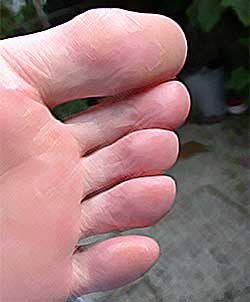Foot
Injuries
Foot injuries can happen to almost anyone
at any time, with the biggest contributing factor being sports
and other athletic pursuits. Your feet have about 25-percent of
all the bones in your body. Besides the 26 bones in each foot,
you also have over 30 joints as well.
Also included is a system of muscles, ligaments
and tendons. Your nerves and blood vessels make up the remaining
physiology of your feet.
Consider all of the abuse your feet take in the
course of a regular day. Walking, tripping, jumping, stubbing
toes on your child's toys. Your feet can take quite a beating.
When you add sports or some other athletic pursuit, it is no wonder
that bone fractures and strained muscles, tendons and ligaments
are to blame for the majority of foot injuries.
The metatarsal bones in your foot are connected to your toes
(or phalanges) and bear the brunt of your weight and movement.
All of the bones in your feet are connected together by tendons
and ligaments. The ligaments tend to link bones and cartilage
together while tendons join the muscles to the bone.
Perhaps the best known part of your foot is your Achilles tendon,
also known as the Achilles heel. It is the strongest tendon in
your body, yet the most susceptible to foot injuries due to the
fact that it is in a vulnerable place, the bottom of your leg.
The Achilles tendon, in layman's terms, attaches the calf muscle
in your leg to your heel bone. Excessive jumping and running are
big culprits in foot injuries and can cause your Achilles to rupture
or tear. It can also be due to someone stepping on your foot or
ankle or not properly warming up before an activity.
Broken bones or stress fractures are also at the top of the foot
injuries list. Repeated foot injuries can wear down the muscles
in your feet, causing them to be able to withstand less and less
impact. A stress fracture occurs when your overworked muscles
transfer the impact of your activity to the bones to absorb. Many
times people may not realize at once that they have broken a bone
because the pain occurs in conjunction with other foot injuries.
Because of the involved physiology of your feet, there are quite
a few foot injuries that can be sustained through a variety of
activities. Whether you are involved in sports or a leisurely
pastime like walking or hiking, it is important to warm-up slowly
and build-up your stamina to avoid hurting yourself. Improper
conditioning and warm-ups are major contributors to foot injuries.
Other types of foot injuries can occur in work-related accidents,
car accidents or due to negligence
on someone's property to name a few. If you do happen to sustain
an injury, it is important to conduct proper first aid in regards
to splinting or immobilization. Afterwards, get to a doctor as
soon as possible so that they can accurately assess the damage
and get you on to the path of healing. Putting off your doctor's
treatment could result in permanent impairment.
If you've received a foot injury caused by someone else, seek
medical attention first. Keep all the documentation and take detailed
notes as they may be useful later if you intend to seek compensation
through the other party's insurance company or if you decide to
seek out your own lawyer. Having a special folder set aside for
medical bills and notes from the injury and medical treatment
have helped many get the compensation they deserve.
|


